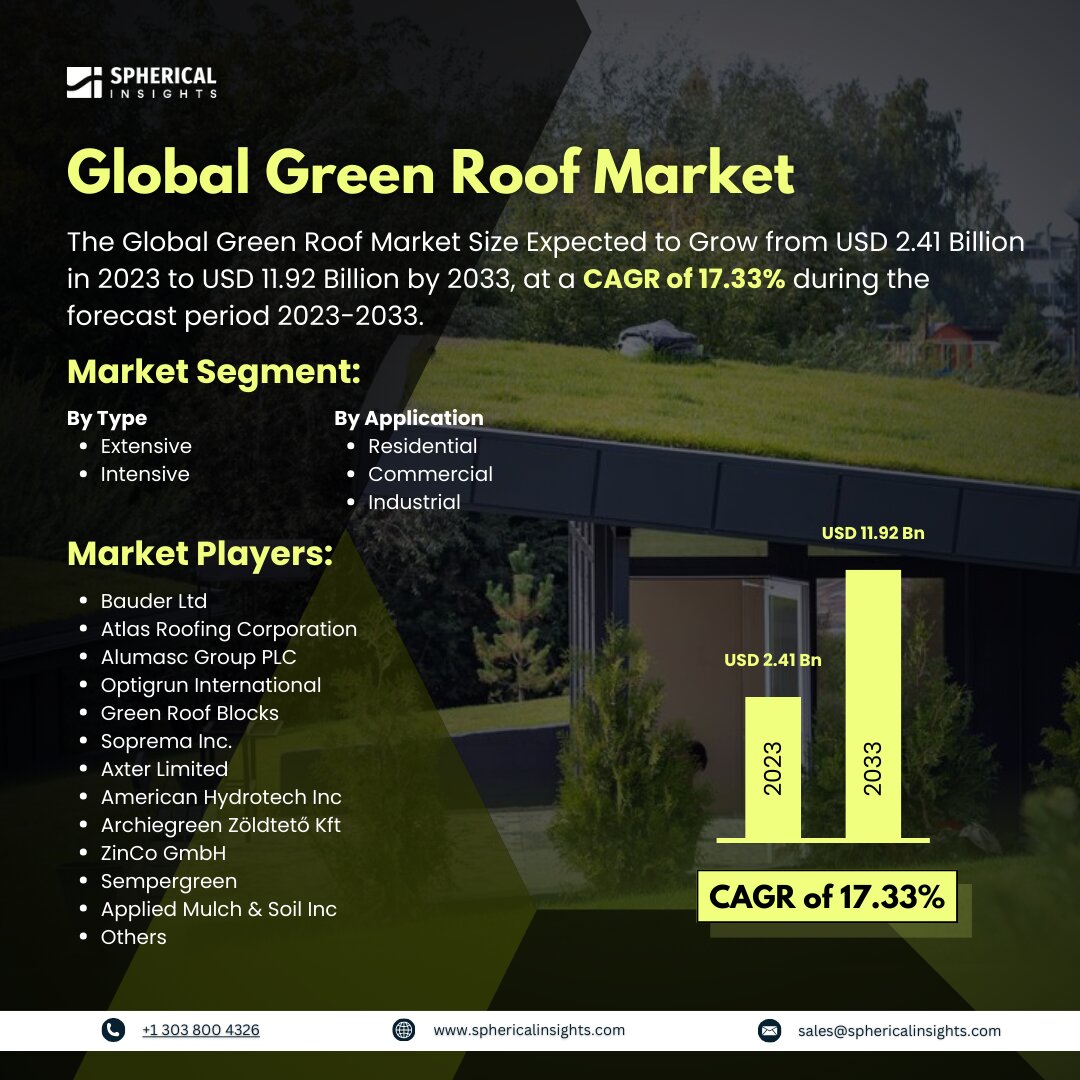Global Green Roof Market Size to Exceed USD 11.92 Billion by 2033
According to a research report published by Spherical Insights & Consulting, the Global Green Roof Market Size Expected to Grow from USD 2.41 Billion in 2023 to USD 11.92 Billion by 2033, at a CAGR of 17.33% during the forecast period 2023-2033.
Browse 210 market data Tables and 45 Figures spread through 190 Pages and in-depth TOC on the Global Green Roof Market Size, Share, and COVID-19 Impact Analysis, By Type (Extensive and Intensive), By Application (Residential, Commercial, and Industrial), and By Region (North America, Europe, Asia-Pacific, Latin America, Middle East, and Africa), Analysis and Forecast 2023 – 2033
The green roof market refers to the industry focused on the design, installation, and maintenance of green roofs. A green roof, sometimes referred to as an eco-roof, rooftop garden, or living roof, is a rooftop that is covered in plants. The need to control stormwater and enhance air quality has grown as a result of urbanization and industry. Properties with green roofs are eligible for storm-water management cost reductions from cities like Washington, DC. Furthermore, the government's and environmental organizations' worldwide tax breaks and incentives for private businesses to install green roofing in their buildings are probably going to be a major driver of the market's expansion in the next years. Green infrastructure is encouraged as part of climate change measures by policies like net-zero carbon targets. Additionally, one of the main factors propelling the growth of the green roof market is the limited space in metropolitan areas. The need for rooftop vertical extension for greening efforts is growing as cities get denser. In locations with a high population density, these green rooftops serve as multipurpose zones. In areas with limited space, urban gardening on rooftops for food production opens up new business opportunities. Additionally, because they draw in inhabitants seeking an environmentally friendly, visually appealing place in urban and denser locations, buildings with green roofs have increased marketability and property value. However, one of the main restraining factors for the green roof market is the high initial installation cost. Green roofs require significant investment in materials, labor, and structural support to ensure they can bear the additional weight of vegetation and soil.
The extensive segment held the highest share in 2023 and is anticipated to grow at a significant CAGR during the projected timeframe.
Based on the type, the global green roof market is categorized as extensive and intensive. Among these, the extensive segment held the highest share in 2023 and is anticipated to grow at a significant CAGR during the projected timeframe. Extensive green roofs' lightweight design lowers the structural load requirements, and their affordability makes them appropriate for a larger variety of sites and property owners. Additionally, large green roofs contribute to urban biodiversity by using drought-resistant plants like sedum and having structural flexibility.
The residential segment held the highest share in 2023 and is anticipated to grow at a significant CAGR during the projected timeframe.
Based on the application, the global green roof market is categorized as residential, commercial, and industrial. Among these, the residential segment held the highest share in 2023 and is anticipated to grow at a significant CAGR during the projected timeframe. This is due to the rise in commercial building construction that has an emphasis on economic benefits, environmental responsibility, and sustainability. Additionally, green roofs can be installed on commercial buildings' spacious rooftops.
North America is projected to hold the largest share of the global green roof market over the forecast period.
North America is projected to hold the largest share of the global green roof market over the forecast period. The industry is being driven by the growing need for energy efficiency, new green roofing technologies, and government incentives and regulations for green roofs in metropolitan areas. Additionally, North American urban livability is being enhanced by green roofs' contribution to the reduction of heat islands in large cities.
Asia-Pacific is expected to grow at the fastest CAGR growth of the global green roof market during the forecast period. The green roof market is growing as a result of several government initiatives that support green roofs as a way to mitigate global warming. Additionally, the Asia Pacific green roof market is driven by growing consumer demand, technical developments, and growing awareness of environmentally friendly solutions.
Competitive Analysis
Major vendors in the global green roof market are Bauder Ltd, Atlas Roofing Corporation, Alumasc Group PLC, Optigrun International, Green Roof Blocks, Soprema Inc., Axter Limited, American Hydrotech Inc, Archiegreen Zoldteto Kft, ZinCo GmbH, Sempergreen, Applied Mulch & Soil Inc, and others.
Key Target Audience
- Market Players
- Investors
- End-users
- Government Authorities
- Consulting and Research Firm
- Venture capitalists
- Value-Added Resellers (VARs)
Key Market Development
- In October 2024, Azizi Developments and Soprema Inc. revealed their collaboration to offer improved and cutting-edge waterproofing solutions.
Market Segment
This study forecasts revenue at global, regional, and country levels from 2020 to 2033. Spherical Insights has segmented the global green roof market based on the below-mentioned segments:
Global Green Roof Market, By Type
Global Green Roof Market, By Application
- Residential
- Commercial
- Industrial
Global Green Roof Market, By Regional
- North America
- Europe
- Germany
- UK
- France
- Italy
- Spain
- Russia
- Rest of Europe
- Asia Pacific
- China
- Japan
- India
- South Korea
- Australia
- Rest of Asia Pacific
- South America
- Brazil
- Argentina
- Rest of South America
- Middle East & Africa
- UAE
- Saudi Arabia
- Qatar
- South Africa
- Rest of the Middle East & Africa



